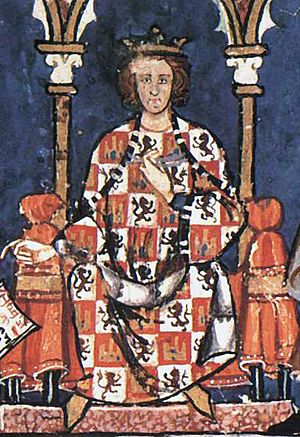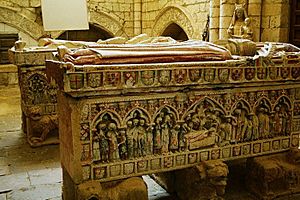Philip of Castile facts for kids
Quick facts for kids Philip of Castile |
|
|---|---|
| Infante of Castile Lord of Valdecorneja |
|

Coat of arms of Philip of Castile
|
|
| Born | 1231 |
| Died | 28 November 1274 (aged 42–43) |
| Burial | Villalcázar de Sirga |
| Spouse | Christina of Norway Inés Rodríguez Girón Leonor Rodríguez de Castro |
| House | Castilian House of Ivrea |
| Father | Ferdinand III of Castile |
| Mother | Beatrice of Swabia |
| Religion | Roman Catholicism |
Philip of Castile (Spanish: Felipe de Castilla y Suabia; 1231 – 28 November 1274) was a prince, also known as an Infante, of Castile. He was the son of King Ferdinand III of Castile and León, and his first queen, Beatrice of Swabia. Philip was also the Lord of Valdecorneja. Some records suggest he was a knight of the Order of the Temple. He was buried in the Church of Santa María la Blanca in Villalcázar de Sirga, in a coffin decorated with Templar symbols.
Philip was chosen to be the Archbishop of Seville. He also served as abbot of important churches in Valladolid and Covarrubias. In 1258, he decided to leave his church career. His brother, King Alfonso X, agreed to this, even though he was against it at first. After leaving the church, Philip married Christina of Norway, who was the daughter of King Haakon IV of Norway.
Contents
Early Life and Education
Infante Philip of Castile was born in 1231. His parents were King Ferdinand III and Beatrice of Swabia. He was named after his mother's father, Philip of Swabia, who was a King of Germany. From a young age, his father prepared him for a life in the church. His brother, Infante Sancho, was also trained for a church career and later became the Archbishop of Toledo.
Philip's grandmother, Queen Berengaria, put him under the care of Rodrigo Jiménez de Rada for his education. Rodrigo later became the Archbishop of Toledo. Philip was sent to Paris to study. There, he learned from Albertus Magnus, who was also the teacher of the famous Thomas Aquinas. In 1249, Pope Innocent IV named Philip as the manager of the Archdiocese of Seville. Two years later, in 1251, the same Pope chose him to be the archbishop-elect of Seville. However, Philip was never officially made a bishop.
Marriage and Family Life
In 1258, Philip's brother, King Alfonso X, allowed him to leave his church duties. Soon after, Infante Philip married Christina of Norway. She was the daughter of King Haakon IV. There was a story that Christina came to Spain because King Alfonso X wanted her to marry him. This was supposedly because his wife, Queen Violant, could not have children. However, this story is not true. Queen Violant had already given birth to several children by 1258.
King Haakon sent Christina to Castile to marry one of King Alfonso's brothers. On her journey, she traveled through France and Aragon. There, King James I of Aragon welcomed her with great respect and even suggested marrying her himself. When Christina arrived in Castile, she met the king's brothers, including Infantes Frederick and Philip. She was to choose one of them as her husband. Christina chose Philip over Frederick. Some say it was because Frederick had a scar on his lip. But later, King Alfonso X stated that he had decided that Christina should marry Infante Philip.
The wedding of Philip and Christina took place in April 1258 in Valladolid. After the marriage, King Alfonso X gave Infante Philip many sources of income. These included taxes from land, tolls, and money from Jewish communities in Ávila. He also received church taxes from the Archdiocese of Toledo and other areas. Philip was also given the estate of Valdecorneja, which included towns like El Barco de Ávila and Piedrahita. The position Philip left in the Archdiocese of Seville was filled in May 1259.
Infante Philip attended important meetings of the Cortes in Seville in 1261. He also attended the wedding of his nephew, Infante Ferdinand de la Cerda, in November 1269. Ferdinand was the son and heir of King Alfonso X.
Philip's first wife, Christina of Norway, died in Seville in 1262. They did not have any children. She was buried in the Collegiate Church of Saints Cosmas and Damian in Covarrubias. Philip had been the abbot there before he left his church duties.
Philip then married Inés Rodríguez Girón. She passed away in 1265 and was buried in the Church of Santa María la Blanca in Villalcázar de Sirga.
His third wife was Leonor Rodríguez de Castro. They had a son named Philip, who died when he was a child. He was buried in the Convent of San Felices de Amaya in Burgos. His mother, Leonor, is also buried there.
Philip also had some children born outside of marriage.
- Fernando Alfonso
- Alfonso Fernández (born around 1263 – died 1284). He served as a chief steward for his uncle, King Alfonso X, in 1283.
- Beatriz Fernández, who became a nun at the Abbey of Santa María la Real de Las Huelgas in Burgos.
The Nobles' Revolt of 1272

In early 1272, a group of powerful nobles gathered in Lerma. They included Nuño González "the Good" de Lara and Lope Díaz III de Haro. Their goal was to challenge King Alfonso X if he did not meet their demands. Infante Philip was at this meeting and spoke for the group. They decided that Philip should talk to the King of Navarre. They wanted to ask for a safe place to go if they had to leave Castile. Philip's third wife, Leonor Rodríguez de Castro, was the daughter of Nuño González de Lara's sister.
Nuño González de Lara was unhappy with the king for several reasons. The king had not given him the land of Durango. Also, the king had criticized his actions in defending Jerez de la Frontera. Many Castilian nobles were unhappy with King Alfonso's way of ruling. They preferred the older ways, where nobles had more power.
After the meeting in Lerma, King Alfonso X tried to find out what happened. He spoke with Infante Philip and Nuño González de Lara. However, Philip avoided answering the king's questions. He also refused to lead his troops to Andalusia for the king. Philip claimed he had not been paid his salary on time. He also said he needed advice and help from friends because his old friends had died.
Nuño González de Lara told the king that the meeting in Lerma was not what it seemed. He even offered to help the king collect new taxes. This would help the king pay his debts to the nobles. In July 1272, King Alfonso X ordered Nuño González de Lara, Infante Philip, and other nobles to come to Seville. They were needed to help Infante Ferdinand de la Cerda defend the border from Muslim attacks. But all the nobles refused to come unless the king met with them first.
Nuño González de Lara pretended to break away from the other rebels. He told the king that the rebels were talking with the King of Navarre. However, letters were soon found that showed the Marinid sultan was also involved in the plot. The sultan wanted to weaken the Castilian king. Even with this proof of betrayal, King Alfonso X decided to negotiate with the rebels. He ordered them to stop talking to the King of Navarre, but they did not obey. Nuño González de Lara then openly broke his agreement with King Alfonso X.
In September 1272, talks started again in Burgos. The nobles refused to stay in the city. They stayed in nearby towns and sent messages to the king through his messengers. The rebels then presented their demands. They complained about the king forcing them to follow royal laws. They also wanted special judges for nobles and were unhappy with the king's officials. They asked for fewer demands to attend the Cortes. They also wanted to be free from a certain tax and asked the king not to create more new towns. After this, King Alfonso X made an alliance with the Kingdom of Navarre. This canceled any agreements between the rebel nobles and Navarre.
After the Cortes of Burgos in 1272, the talks broke down. The rebels, including Infante Philip and Nuño González de Lara, left for the Kingdom of Granada. King Alfonso tried one last time to stop them. He sent his son, Infante Ferdinand de la Cerda, and his brother, Manuel, to persuade them. But the nobles ignored his pleas. Before reaching Granada, they robbed the countryside, stealing cattle and destroying land. The king sent them letters reminding them of his past favors and their broken loyalty. He specifically reminded Nuño González de Lara that he had given him the estate of Écija against his own father's wishes.
Still, the rebel nobles went to Granada. There, King Mohammed I welcomed them with honor. They signed a treaty with him in Sabiote. In this treaty, the nobles and Muhammad promised to help each other against Alfonso X until the king met their demands. Infante Philip, Nuño González de Lara, and other important nobles signed this treaty.
In January 1273, in Tudela, Infante Philip and other nobles pledged loyalty to King Henry I of Navarre. They showed him documents about the harm they claimed Alfonso X had caused them. They also presented their demands. This meant they were free from their loyalty to Alfonso. They then served the King of Navarre, just as they had served the King of Granada.
The king sent a church official, Fernán Pérez, to talk to Infante Philip. He hoped to persuade Philip to leave the rebel group, but it did not work. In early 1273, Juan Núñez de Lara, who had been a mediator between his father Nuño and the king, also left the king's side.
Despite this, King Alfonso X wanted to be chosen as the leader of the Holy Roman Empire. So, he allowed some royal family members to restart talks with the exiled nobles. These included Infantes Ferdinand de la Cerda and Manuel, Queen Violant, and Archbishop Sancho. After many talks, King Alfonso agreed to most of the demands from the exiled nobles. Nuño González de Lara met with Queen Violant in Córdoba in 1273. By the end of that year, the exiled nobles returned to Castile. At the same time, King Muhammed II of Granada declared himself a loyal follower of Alfonso X.
Death and Burial
Infante Philip of Castile died on 28 November 1274. He was 43 years old. This date is carved on his tomb.
His body was buried in the Church of Santa María la Blanca in Villalcázar de Sirga. This church was connected to the Order of the Temple. It is located in the province of Palencia, about 10 kilometers from Carrión de los Condes.

The same church holds the tomb of his second wife, Inés Rodríguez Girón. In the past, people thought it was the tomb of his third wife, Leonor Rodríguez de Castro. But the symbols on the tomb show it belongs to the Girón family, not the Castro family.
Infante Philip's remains are in a Gothic tomb. It is in the church's chapel of St James, next to his second wife's tomb. In the same chapel, there is another tomb from the 14th century. It holds the remains of a knight from the Order of Santiago. Philip's and his wife's tombs were once in the church's choir. They were moved to their current spot by a local commission.
See also
 In Spanish: Felipe de Castilla para niños
In Spanish: Felipe de Castilla para niños

